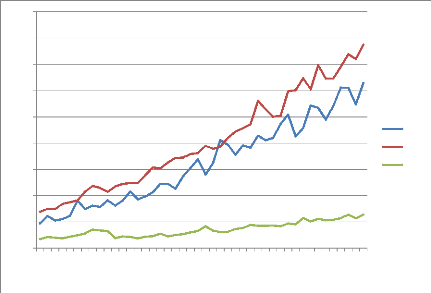2.6 Relationship between Economic Growth and Tax
Revenue evolution from 2007 to 2017
2007Q1 2007Q3 2008Q1 2008Q3 2009Q1 2009Q3 2010Q1 2010Q3 2011Q1
2011Q3 2012Q1 2012Q3 2013Q1 2013Q3 2014Q1 2014Q3 2015Q1 2015Q3 2016Q1 2016Q3
2017Q1 2017Q3
|
2,500 2,000 1,500 1,000
500
-
|
|
|
|
|
Nominal GDP Total tax revenues
|
Source: Authors' computation based on RRA and
NISR data
P a g e 24 | 48
P a g e 25 | 48
During the past decade spanning from 2007Q1 to 2017Q4, Nominal
GDP was 484billion to 1985billion from 2007Q1 to 2017Q4 and Total tax revenues
was 54billion to 306 billion from 2007Q1 to 2017Q4.During the 2007Q1 to 2017,
the tax-to-GDP ratio has increased from 11.5 percent to 15.4 percent
respectively.

180
160
140
120
100
40
80
60
20
-
2007Q1 2007Q3 2008Q1 2008Q3 2009Q1 2009Q3 2010Q1 2010Q3 2011Q1
2011Q3 2012Q1 2012Q3 2013Q1 2013Q3 2014Q1 2014Q3 2015Q1 2015Q3 2016Q1 2016Q3
2017Q1 2017Q3
DT
TGS
TITT
Source: Authors' computation based on RRA
data
Looking at different components of each tax revenue, the figure 2
above shows that the taxes on goods and services from is the biggest
contributor with 28 billion to 166 billion from 2007Q1 to 2017Q4, direct taxes
is second with 19 billion to 126 billion from 2007Q1 to 2017Q4 and lastly tax
on international trade and transaction with 7 billion to 26 billion from 2007Q1
to 2017Q4
P a g e 26 | 48
CHAPTER 3: RESEARCH METHODOLOGY
3.1. Introduction
This chapter describes the methodology was done on the
following sub-headings of introduction, research design, theoretical framework,
Related case studies and summary, data collection techniques and tools, data
processing, methods of data analysis, limitation, ethical consideration and
model specification
3.2. RESEARCH DESIGN
A research design is a master plan specifying the methods and
procedures for collecting and analyzing the required information. Research
design is the plans and the procedures for research that span the decisions
from broad assumptions to detailed methods of data collection and analysis. The
overall decision involves which design should be used to study a topic.
Informing this decision should be the worldview assumptions the researcher
brings to the study; procedures of inquiry (called strategies); and specific
methods of data collection, analysis, and interpretation.
The selection of a research design is also based on the nature
of the research problem or issue being addressed, the researchers' personal
experiences, and the audiences for the study. ( Creswell,2008,P .3) According
to Grinner and Williams (1990,P.279), research design is the entire process of
the study, the problem formulation through dissemination of findings. It
sometimes used to refer to graphic presentation of the independent variables.
According to Churchill (1992:39), «a study design is simply the frame work
or plan for the study used as a guide in collecting and analyzing data».
The research design related to this study was based on the techniques set at
each objective to have all the objectives achieved.
| 


